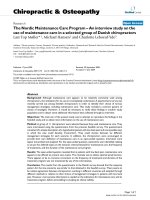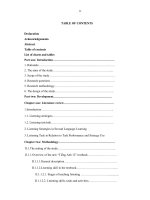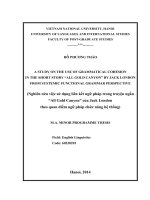A study on the use of communicative activities to improve ESP reading skills for civil engineering students at university of civil engineering
Bạn đang xem bản rút gọn của tài liệu. Xem và tải ngay bản đầy đủ của tài liệu tại đây (379.39 KB, 5 trang )
VIETNAM NATIONAL UNIVERSITY, HANOI
UNIVERSITY OF LANGUAGES AND INTERNATIONAL STUDIES
FACULTY OF POST-GRADUATE STUDIES
VŨ THỊ THẢO
A STUDY ON THE USE OF COMMUNICATIVE ACTIVITIES TO
IMPROVE ESP READING SKILLS FOR CIVIL ENGINEERING
STUDENTS AT UNIVERSITY OF CIVIL ENGINEERING
(Nghiên cứu việc sử dụng các hoạt động giao tiếp giúp phát triển kỹ năng
đọc tiếng Anh chuyên ngành cho sinh viên Trường Đại học Xây dựng)
M.A Minor Programme Thesis
Field: English Methodology
Code: 601410
HÀ NỘI – 2010
VIETNAM NATIONAL UNIVERSITY, HANOI
UNIVERSITY OF LANGUAGES AND INTERNATIONAL STUDIES
FACULTY OF POST-GRADUATE STUDIES
VŨ THỊ THẢO
A STUDY ON THE USE OF COMMUNICATIVE ACTIVITIES TO
IMPROVE ESP READING SKILLS FOR CIVIL ENGINEERING
STUDENTS AT UNIVERSITY OF CIVIL ENGINEERING
(Nghiên cứu việc sử dụng các hoạt động giao tiếp giúp phát triển kỹ năng
đọc tiếng Anh chuyên ngành cho sinh viên Trường Đại học Xây dựng)
M.A Minor Programme Thesis
Field: English Methodology
Code: 601410
Supervisor: Prof. Dr. Hoàng Văn Vân
HÀ NỘI – 2010
4
TABLE OF CONTENTS
DECLARATION
Acknowledgement
Abstract
Table of content
Abbreviations
Lists of Charts and Tables
PART I: INTRODUCTION
1. Rationale ..................................................................................................................... 1
2. Aims of the study ........................................................................................................ 2
3. Significance of the Study ............................................................................................. 2
4. Scope of the Study....................................................................................................... 2
5. Research questions ...................................................................................................... 2
6. Methods of the study ................................................................................................... 3
7. Design of the study ...................................................................................................... 3
PART II: DEVELOPMENT
Chapter 1: Theoretical Background ............................................................................. 4
1.1. What is reading? ....................................................................................................... 4
1.2. Role of reading ......................................................................................................... 4
1.3. Reading skills ........................................................................................................... 5
1.4. What is reading comprehension? .............................................................................. 7
1.5. Reading in ESP teaching and learning ...................................................................... 8
1.5.1. Definition of ESP? ..................................................................................... 8
1.5.2. Reading skills in ESP ................................................................................. 8
1.5.3. Teaching reading ESP ................................................................................ 9
1.5.3.1. The roles of reading students ................................................................... 9
1.5.3.2. The roles of reading teachers ................................................................... 10
1.5.3.3. The reading material’s roles .................................................................... 12
1.5.4. Approaches to teaching Reading skills ....................................................... 13
1.5.5. Principles of teaching reading .................................................................... 13
1.6. Theoretical background of Communicative Language Teaching (CLT) .................... 14
1.6.1. Introduction and definition of CLT ............................................................. 14
5
1.6.2. Basic features of communicative approach ................................................. 14
1.6.3. Definition of communicative activities ....................................................... 15
1.6.4. Using of communicative activities in ESP reading skills ............................ 17
1.6.4.1. Using communicative activities in the class ............................................. 17
1.6.4.2. Special features of Civil Engineering texts .............................................. 18
1.6.4.3. Information-gap activity and Information-transfer activity....................... 20
Chapter 2: The Quasi-experiment ................................................................................ 22
2.1. Background to the study ........................................................................................... 22
2.1.1. Introduction of the University of Civil Engineering .................................... 23
2.1.2. The teachers ............................................................................................... 23
2.1.3. The ESP students ....................................................................................... 24
2.1.4. The course book ......................................................................................... 24
2.2. The quasi-experiment ............................................................................................... 25
2.2.1. Organization .............................................................................................. 25
2.2.1.1. The subjects ............................................................................................ 25
2.2.1.2. The teachers ............................................................................................ 25
2.2.1.3. Main testing instruments: Pre-test and post-test ....................................... 25
2.2.2. Realization Stage ....................................................................................... 26
2.2.3. Summary of the quasi-experimental process ............................................... 30
Chapter 3: Data Analysis, Results and Discussions ..................................................... 31
3.1. Interpretation of result stage ..................................................................................... 31
3.1.1. Classroom observation results ................................................................................ 31
3.1.2. The post-test results ............................................................................................... 32
PART III: CONCLUSION
1. Summaries ................................................................................................................ 39
2. Suggestions............................................................................................................... 40
3. Limitations and suggestions for further research ....................................................... 42
REFERENCES
APPENDICES
Appendix 1: The post-test 1
Appendix 2: The post-test 2
Appendix 3: The post-test 3
Thank you for evaluating AnyBizSoft PDF
Merger! To remove this page, please
register your program!
Go to Purchase Now>>
AnyBizSoft
PDF Merger
Merge multiple PDF files into one
Select page range of PDF to merge
Select specific page(s) to merge
Extract page(s) from different PDF
files and merge into one









